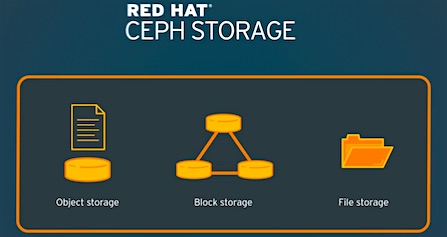Sydney, Starnberg, 07. Nov. 2017 - Zentrale Neuerungen sind die Unterstützung von Block-Storage über iSCSI, File-Storage über CephFS und eine reduzierte Komplexität...
Zum Hintergrund: Auf dem derzeit stattfindenden Openstack Summit 2017 in Sydney hat Red Hat mit Ceph Storage 3 die nächste Generation seiner massiv skalierbaren Software-defined-Object-Storage-Plattform vorgestellt (1). Nach V.1 (inktank mit RHEL Integration), V.2 mit Object Storage bietet V.3 mit Einführung von CephFS (POSIX-kompatibles distributed Scale-out-File-System) eine Erweiterung der bisherige Block- und Object-Storage-Unterstützung, hin zu Unified Software Defined Storage. Betreiber können damit Storage effizienter mit OpenStack in Private-Cloud-Umgebungen und verschiedenen Anwendungsfällen nutzen, einschließlich Webscale-Cloud, Network Functions Virtualization infrastructure (NFVi) sowie Entwicklungs- oder Compute-Clouds.
Red Hat Ceph Storage 3 basiert auf der Community-Version des Open-Source-Projekts Ceph Luminous, an dem Red Hat maßgeblich beteiligt ist. Red Hat Ceph Storage 3 wird laut Anbieter voraussichtlich noch in diesem November allgemein verfügbar sein. Hier ein kurzer Überblick zu den Neuerungen:
Mit Hilfe der iSCSI-Schnittstellen-Integration werden mehr Plattformen und eine größere Bandbreite von Anwendungsfällen unterstützt, einschließlich Backup und Recovery. Von Vorteil ist die Unterstützung heterogener Plattformen vor allem bei Storage-Umgebungen mit VMware und Windows, in denen es keinen nativen Ceph-Treiber gibt. Das iSCSI-Gateway ermöglicht die Nutzung einer skalierbaren Block-Storage-Plattform für vorhandene virtuelle Infrastrukturen wie z.B. VMware und daneben die Verwendung von Ceph mit modernen Workloads – und reduziert damit den Bedarf an dedizierten Storage Area Networks (SANs).
Durch die Bereitstellung von Enterprise-Storage in Linux-Containern wird der Betrieb vereinfacht und der Hardware-Bedarf gesenkt. Containerisierte Storage-Daemons ermöglichen es, Red Hat Ceph Storage auf einer geringeren Anzahl an Servern durch Zusammenlegung von Services zu nutzen, die vorher dedizierte Hardware erforderten, wobei das Risiko von Ressourcenkonflikten vermieden wird (ein Container-Image mit allen notwenigen Services). Mit Tools wie Ansible lässt sich ein hoher Automationsgrad erzielen, was die bislang erhöhte Komplexität von Ceph deutlich reduzieren soll.
Das Objektspeichersystem von Ceph ist nicht auf native Bindings oder RESTful APIs beschränkt; Ceph läßt sich als Thin Provisioned Block Device einbinden. Wenn Daten mit einem Block-Device in Ceph geschrieben werden, repliziert Ceph diese automatisch als Stripe Set über den Cluster.
Nach Auskunft von Red Hat ist CephFS jetzt Produktionsstabil und damit für Unternehmens-Workloads robust einsetzbar. Targets sind Linux mit Ceph FS client und OpenStack als private Cloud O/S Plattform, während für andere Umgebungen derzeit noch NFS oder SMB als zusätzliche Protokollschicht benötigt wird (File share as a service mit ceph manila).

Abb. 1: Red Hat Ceph Storage (Bildquelle: Red Hat)
(1) Quelle: Auszug der Red Hat Originalmeldung zur Ankündigung in englischer Sprache:
"Eases migration from legacy storage platforms through newly added support for the iSCSI interface for wider platform support and increased breadth of use cases, including backup and recovery. This is particularly beneficial to heterogeneous storage environments such as VMware and Windows that lack a native Ceph driver. The iSCSI gateway enables enterprises to use a single, cost-effective, and highly scalable, block storage platform for existing virtualization infrastructure alongside their use of Ceph with modern workloads, reducing the need for dedicated Storage Area Networks (SAN).
Deploys enterprise storage in Linux containers for simplified operations and a smaller hardware footprint. Containerized storage daemons enable users to run Red Hat Ceph Storage on fewer servers by co-locating services that previously required dedicated hardware, while avoiding the risk of resource conflicts. Preliminary tests based on a standard Red Hat Ceph Storage cluster configuration showed lowered hardware expenditure by at least 24 percent. This is particularly relevant to telco customers, such as those implementing NFVi, who struggle with hardware and space constraints
Red Hat Ceph Storage 3 also aims to significantly improve the user experience by helping administrators proactively monitor and troubleshoot distributed storage clusters via a graphical view of usage data for the cluster as a whole, or its individual components. The new web-based interface, which includes more than a dozen dashboards, is based on the upstream Ceph Metrics project. This release also adds several other usability enhancements and layers of automation, such as dynamic bucket sharding, designed to help simplify maintenance and lower operational costs.
Red Hat Ceph Storage 3 Broadens the Reach for Enterprise Workloads: The Latest release of industry-leading object storage platform strengthens support for OpenStack and heterogeneous environments, improves usability and performance."
Anwenderkommentare
Blair Bethwaite, senior HPC consultant, Monash eResearch Center: "Providing enough scalable object-based storage to meet the capacity needs of our online architecture has been critical for our researchers and our Node of the National eResearch Collaboration Tools and Resources (Nectar) research cloud. Monash has worked extensively and successfully with Red Hat Ceph Storage for nearly two years to support a variety of use cases including the Nectar project. We are excited about achieving even greater economies with containerized storage daemons in Red Hat Ceph Storage 3, and new support for iSCSI and CephFS gives us the opportunity to service native Windows research workstations around the campus and offer programmatic access to project-specific file systems in our OpenStack clouds.”
Bryan Thompson, general manager of OpenStack Private Cloud, Rackspace: "Rackspace has continued to work with Red Hat to refine and innovate our award-winning Rackspace OpenStack Private Cloud powered by Red Hat offering since launching it in February 2016. Red Hat Ceph Storage is an integral part of our private cloud offering. We are excited by the continued innovation in the Ceph project, and the lengths that Red Hat goes to support successful consumption in an enterprise setting.”
Link > Red Hat Storage
Link > Red Hat Ceph Storage
Link > Register to attend the Nov. 8 Webinar "Introducing Red Hat Ceph Storage 3"
